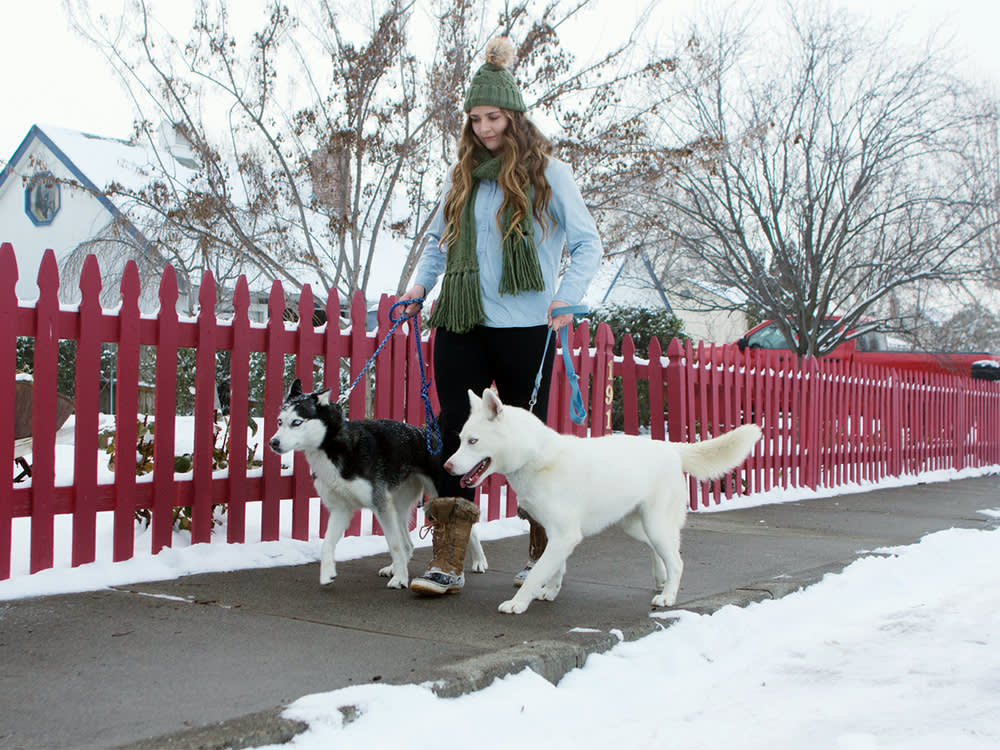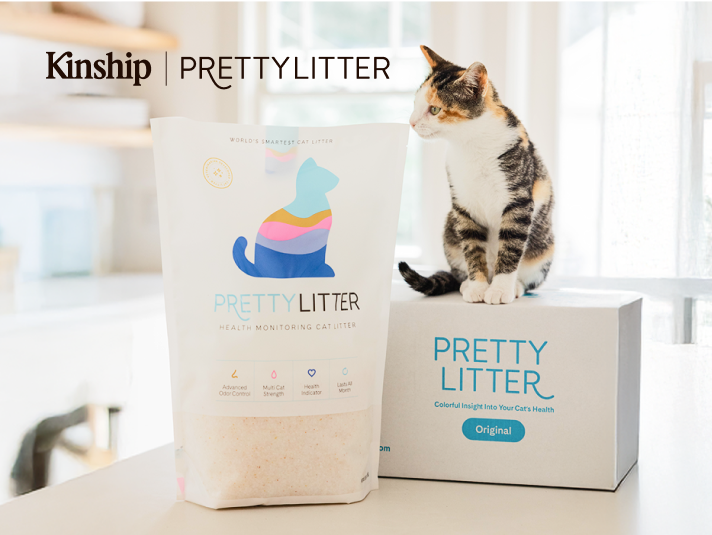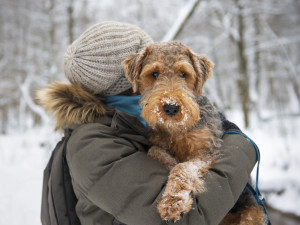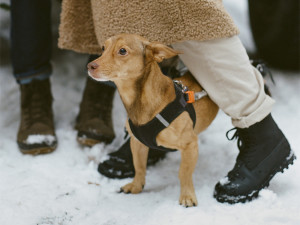How to Keep Your Dog’s Paws Safe From Snow Salt
Tips for safe, snug, and happy paws this winter.

Share Article
Taking your dog out in the snow can either be a magical experience or a treacherous feat. As some dogs frolic in backyard paradises blanketed in sparkling snow, others walk cautiously along slick sidewalks, unknowingly treading on harmful salts as they attempt to do their business. We get why snow salts are needed, but we all should really be paying closer attention to how they affect our dogs. Snow salts can cause major damage to our canine companion’s paws, and they can be extremely toxic if ingested.
So, is there a way to enjoy winter walks without the potential risks? Thankfully, there is. Here’s how snow salts affect paws, what you should do if your pup has a snow salt injury, and how you can protect those precious paws moving forward.

Save on the litter with color-changing tech that helps you better care for your cat.
How do snow salts affect paws?
Snow salts have long been used to melt ice and snow, providing safer conditions for pedestrians and drivers during the wintertime. And while this may be helping humans avoid accidents, it’s wreaking havoc on our pets’ paws. Snow salts are typically made from chemicals like sodium chloride or calcium chloride, and walking on them can cause irritation, injury, and even chemical burns.
“Chemical burns are noted most commonly around the paw pads,” says Alex Blutinger, medical director of Veterinary Emergency Groupopens in new tab White Plains & Greenwich. “Pet parents may see ulcerated lesions, swelling, bleeding, and reddening of the pads or skin between the pads.”
Next time you walk your dog on snow-salted sidewalks, keep your eyes peeled for these signs of a snow salt injury:
Open sores and wounds
Swelling or inflammation
Bleeding
Dry, cracked paws
Red paw pads or skin between the pads
Beyond these visual cues, you might observe behaviors such as limping or excessive paw licking, which can signal discomfort or irritation. This is a sign that you should investigate what’s afoot beneath their paws.
How to treat injuries from snow salt
It’s important to treat a snow salt injury as soon as you notice one so the wound doesn’t get worse or lead to infection. You may be able to treat minor injuries at home; however, more serious injuries should be treated by a veterinarian.
“If a pet parent notices these lesions developing, they should try to prevent their pet from licking the affected area to avoid infection,” Dr. Blutinger recommends. “Gently cleaning the area with a damp cloth is reasonable, but emergency veterinary care should be sought if the dog is uncomfortable, there is an open wound, or the area appears infected.”
Ultimately, once you notice something’s up with your dog’s paw, you should first prevent them from licking it. You can either do this by putting a sock over it while you figure out next steps, or you can use an Elizabethan collar (also called a cone) if you have one. If it seems like a minor injury, you can clean it gently with a damp cloth. If your pup winces when you do that or the wound appears to be more serious, you should take them to the vet ASAP, because delaying treatment can lead to deeper wounds and infection.
Ways to protect paws from snow salts
The reality is that we still have to walk our dogs regardless of what the weather is doing. Fortunately, there are ways to mitigate irritation from snow salts. Per Dr. Blutinger, there are several options for preventing chemical irritation from ice melt. These include:
“Paw wax or dog booties provide a great barrier to minimize the risk of irritation,” Dr. Blutinger says. “Cleaning the paw pads after walks with a damp cloth or baby wipes is also an effective way of preventing chemical irritation.”
It can be as simple as lathering on some paw wax or adding a pair of boots to your dog’s winter wardrobe before you leave for your walk. Plus, cleaning your dog’s paws after walks is a healthy habit to adopt, regardless of the weather. It helps remove any residual dirt, salt, or ice melt and prevents irritation or discomfort. As a bonus, it keeps your home more sanitary — it’s a win-win for everyone.
Pet-safe snow salt alternatives
In addition to taking precautions before you set out on your winter walks, there are some pet-safe snow salt options on the market if you’re looking to use some around your own home. Look for one that’s free of corrosive material and harmful ingredients such as salt and chloride.
“Safe Paw is a pet-safe ice melt alternative that is chloride, salt, and acetate-free,” Dr. Blutinger says. “It has special glycols and non-ionic surfactant accelerants. It is a non-corrosive chemical and made from naturally occurring material, so it is not harmful if ingested.”
Whether you use pet-safe ice melt around your home, snag a pair of winter dog boots, or thoroughly clean those post-walk paws, it’s our job to keep our pet’s paws safe during the wintertime. By prioritizing paw health, we can ensure that canine companions continue to enjoy snowy adventures with us for years to come.
More things to consider:
Can dogs walk on snow salt?
Yes, dogs can walk on snow salt, but it’s important to take precautions to protect their paws. Snow salt, or ice melt, is often used to melt ice and snow on sidewalks and roads during the winter months.
However, the chemicals in some snow salts can be harmful to dogs’ paw pads, causing irritation, dryness, and even chemical burns. To minimize the risk, consider using pet-safe ice melt products or outfitting your dog with winter boots before walking on treated surfaces.
Is salt for snow toxic?
Yes, some types of salt used for melting snow and ice can be toxic to dogs if ingested in large quantities. Common snow salts contain chemicals such as sodium chloride, calcium chloride, and potassium chloride, which can cause gastrointestinal upset, vomiting, diarrhea, and even salt poisoning in dogs.
Exposure to salt can also irritate a dog’s skin and paw pads, leading to discomfort and potential injury. It’s essential to thoroughly clean your dog’s paws after walks to prevent ingestion and minimize exposure to harmful chemicals.
If you suspect your dog has ingested snow salt or is showing signs of salt poisoning, seek veterinary care immediately.

Courtney Elliott
Courtney Elliott, a proud Cleveland native living in Manhattan, blends her decade of writing and editing expertise with her unshakable devotion as a pet parent to her French Bulldog, Gus. When she’s not at her desk, you’ll find her frolicking in Central Park or engrossed in a good book at a local coffee shop.
Related articles
![Pit Bull dog wearing a coat on leash with person in the snow]()
Does Your Dog Need a Winter Coat?
Chilly pup refusing to layer? Here’s how to train them to love their winter wardrobe.
![Happy Chihuahua dog running outdoors wearing blue jacket in winter snow]()
23 Winter Trappings for the Dog With Outdoorsy Parents
Ski-club balaclavas, waterproof wellies, all-natural nose balm, and more gear to help outdoorsy pet parents get the most out of the season.
![Shetland sheepdog sits in front of a obstacle course for dogs in the living room]()
3 Fun Indoor Games to Play With Your Dog This Winter
Bad weather? These activities will keep your dog (and you!) from going stir crazy.
![Person with two small dogs that won't poop in snow]()
How to Teach Your Dog to Poop in the Snow
Snow days are fun—until your pup needs to do their thing outside.
![A couple bundled up for winter standing outside in the snow with their dog.]()
Can Dogs Get Frostbite?
Yep, all those warnings your mom gave you as a kid apply to your dog, too. Learn how to keep your pup safe in the cold.
![a woman pets her dog in a coat while outside in the snow]()
How Cold Is Too Cold for Dogs?
If your teeth are chattering, theirs probably are, too.







